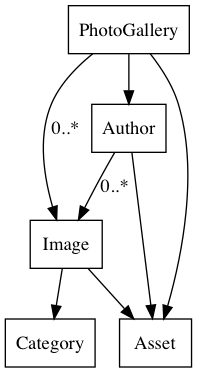contentful-graph
Visual representation of contentful content models in form of graphs
Can be exported with fields:
or without:
Requirements
graphviz
If you plan to render the graph as image or PDF, make sure you have graphviz installed on your system.
node.js
The library is using async/await functions, so you need the latest 7 or 8 versions.
Installation
Can be installed globally:
npm i -g contentful-graph
Or locally
npm i --save-dev contentful-graph
Running without installation
Import script can be executed with the help of npx
npx contentul-graph
Running import
There are several ways of running the import:
- running CLI
bin/contentful-graphcommand - import API and invoking functions programmatically
For this purpose, you'll need to know your contentful spaceId and token
Token may come in two flavors: Delivery token or Management token
Management token has an advantage of showing one-to-one relationships for models (as pointed by @jelz in #1)
Command-line version
When running the command line version, make sure you export following variables:
CONTENTFUL_SPACE_ID= spaceId
CONTENTFUL_TOKEN= either deliveryToken
CONTENTFUL_MANAGEMENT_TOKEN= or management token
CONTENTFUL_ENVIRONMENT_ID= environment idor simply in command-line:
CONTENTFUL_ENVIRONMENT_ID=master CONTENTFUL_SPACE_ID=123 CONTENTFUL_MANAGEMENT_TOKEN=token ./bin/contentful-graph
Command-line options
--help (-h) Displays usage information
--dev (-d) Includes developer information (model Id's and field Id's)
--hide-fields (-n) Do not include fields information, only entities
Reading from local file
It is possible to run import against local file with exported model defintions:
./bin/contentful-graph ./my-contentful-model.jsonWeb version
You can run it locally or host it on any server using contentful-graph-web
docker run -it --rm -p 3000:3000 lotas/contentful-graph-web
# or checkout project locally and
make BUILD && make RUN
# or if you have graphviz in your system simply
npm run devApi version
Package exposes following functions:
getContentTypesFromManagementApi(spaceId: string, managementToken: string, environment: string): Promise<Object>
Will import content types from contentful using management api
getContentTypesFromDistributionApi(spaceId: string, apiToken: string, environment: string): Promise<Object>
Will import content types from contentful using distributions api
contentTypesToModelMap(contentTypes: Object): Object
Will enrich existing content types with mapping information (one-to-one, one-to-many)
modelsMapToDot(modelsMap: Object, {hideEntityFields: Boolean, dev: Boolean}): String
Will create dot graph definition out of the model map
You can use them as follows:
const convertApi = require('contentful-graph');
// either with managementToken
const contentTypes = await convertApi.getContentTypesFromManagementApi(spaceId, managementToken);
// or with apiToken, you just need one of the calls
const contentTypes = await convertApi.getContentTypesFromDistributionApi(spaceId, apiToken);
// enrich content types with relationship definitions
const modelsMap = convertApi.contentTypesToModelMap(contentTypes);
// generate dot string that can be passed to graphviz
const dotStr = convertApi.modelsMapToDot(modelsMap, {});Generating graphs
After you would run the import, you should have something like this:
digraph obj {
node[shape=record];
Image [label="{Image | | <title> Title|<photo> Photo|<imageCaption> Image caption|<imageCredits> Image credits|<categoryId> CategoryId}" shape=Mrecord];
Asset
Author [label="{Author | | <name> Name|<twitterHandle> Twitter handle|<profilePhoto> Profile photo|<biography> Biography|<createdEntries> Created entries}" shape=Mrecord];
Category [label="{Category | | <categoryId> Category Id|<categoryName> Category name}" shape=Mrecord];
PhotoGallery [label="{Photo Gallery | | <title> Title|<slug> Slug|<author> Author|<coverImage> Cover Image|<description> Description|<images> Images|<tags> Tags|<date> Date|<location> Location}" shape=Mrecord];
Image:photo -> Asset [dir=forward];
Image:categoryId -> Category [dir=forward];
Author:profilePhoto -> Asset [dir=forward];
Author:createdEntries -> Image [dir=forward,label="1..*"];
PhotoGallery:author -> Author [dir=forward];
PhotoGallery:coverImage -> Asset [dir=forward];
PhotoGallery:images -> Image [dir=forward,label="1..*"];
}To render this to image or PDF, pipe it to the dot command:
./import.js | dot -Tpng > model.png
./import.js | dot -Tpdf > model.pdfWhere ./import is the script that produces dot output

